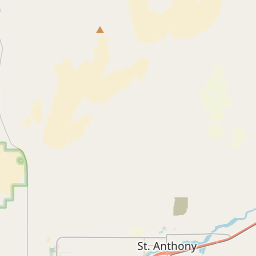Sub-Irrigation on Egin Bench
Historical marker location:
132 North Center Street, Paker, Idaho
( Marker is at the intersection of North Center Street and East Cedar Street on North Center Street.)













© OpenStreetMap contributors
The state's first female governor was elected in 1990. Her name was Cecilia M. "Cec" Andrus, and she was the wife of former governor and US Secretary of the Interior, Cecil D. Andrus.
About Fremont County
Fremont County Timeline
Fremont County, Idaho, located in the western United States, has a rich and varied history dating back thousands of years. The region was originally inhabited by Native American tribes, including the Shoshone-Bannock, Northern Paiute, and Shoshone-Caribou, who lived off the land through hunting, fishing, and gathering. The area was part of the larger Oregon Territory, claimed by the United States in the early 19th century.
In 1863, Fremont County was established as one of the five original counties of the Idaho Territory. The county was named after the famed explorer and military officer, John C. Fremont. At that time, the main economic activity in the area was fur trading, as the county was strategically located near major fur trapping areas. However, the discovery of gold in the Salmon River and Lemhi Valley in the 1860s brought a rush of prospectors to the region, leading to a sharp increase in population.
Over the next few decades, mining became the dominant industry in Fremont County, with gold, silver, and other minerals being extracted from the hills and mountains. The mining boom brought not only wealth but also a surge in settlement and infrastructural development. Towns such as St. Anthony and Ashton grew rapidly as trading posts, support centers, and transportation hubs. The construction of railroads further facilitated the growth of the mining industry and linked Fremont County to larger markets.
In the early 20th century, the mining industry began to decline, causing a shift in the county's economy. Agriculture and tourism emerged as the new primary economic drivers. The region's fertile soil and favorable climate made it suitable for farming, particularly potato cultivation. Today, Fremont County continues to be an important agricultural region, known for its production of potatoes, grains, livestock, and dairy products. Additionally, the county's scenic beauty and outdoor recreational opportunities make it a popular destination for tourists and outdoor enthusiasts.
In 1863, Fremont County was established as one of the five original counties of the Idaho Territory. The county was named after the famed explorer and military officer, John C. Fremont. At that time, the main economic activity in the area was fur trading, as the county was strategically located near major fur trapping areas. However, the discovery of gold in the Salmon River and Lemhi Valley in the 1860s brought a rush of prospectors to the region, leading to a sharp increase in population.
Over the next few decades, mining became the dominant industry in Fremont County, with gold, silver, and other minerals being extracted from the hills and mountains. The mining boom brought not only wealth but also a surge in settlement and infrastructural development. Towns such as St. Anthony and Ashton grew rapidly as trading posts, support centers, and transportation hubs. The construction of railroads further facilitated the growth of the mining industry and linked Fremont County to larger markets.
In the early 20th century, the mining industry began to decline, causing a shift in the county's economy. Agriculture and tourism emerged as the new primary economic drivers. The region's fertile soil and favorable climate made it suitable for farming, particularly potato cultivation. Today, Fremont County continues to be an important agricultural region, known for its production of potatoes, grains, livestock, and dairy products. Additionally, the county's scenic beauty and outdoor recreational opportunities make it a popular destination for tourists and outdoor enthusiasts.
Fremont County Timeline
This timeline provides a condensed summary of the historical journey of Fremont County, Idaho.
- Fremont County, ID was established in 1893.
- In 1917, the Yellowstone National Park boundary was adjusted, resulting in the inclusion of the southwest portion of Fremont County.
- In the 1930s, the Teton Dam was constructed on the Teton River in Fremont County.
- In 1976, the Teton Dam failed, resulting in a catastrophic flood that affected Fremont County and the surrounding areas.
- Throughout the late 20th century, Fremont County underwent significant agricultural development, with the expansion of potato farming and the introduction of large-scale dairy operations.
- In 2000, the Teton Geotourism Center was opened in Driggs, providing educational information about the geology and natural history of the region.
- In recent years, Fremont County has seen a growth in tourism, particularly due to its proximity to Yellowstone National Park and the Teton Mountains.